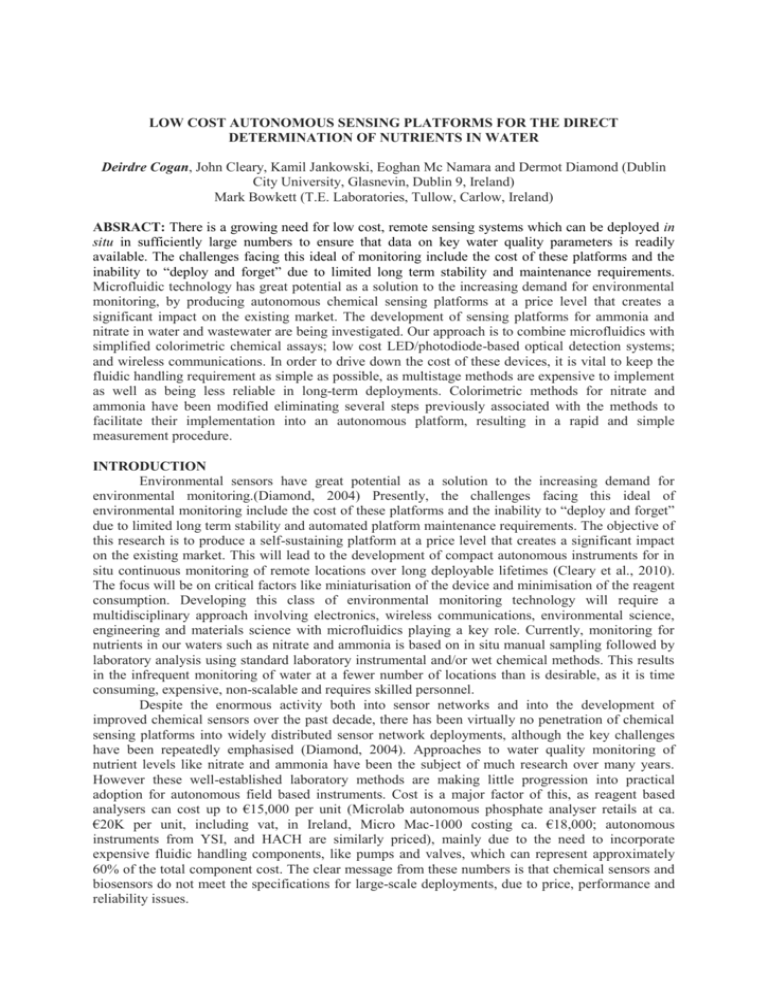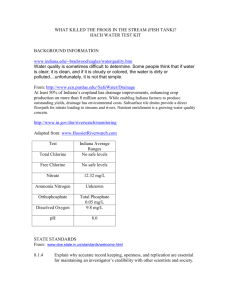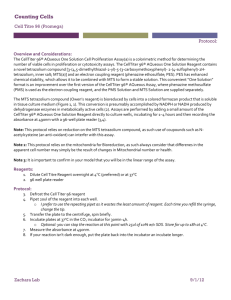Low cost autonomous sensing platforms for the direct
advertisement

LOW COST AUTONOMOUS SENSING PLATFORMS FOR THE DIRECT DETERMINATION OF NUTRIENTS IN WATER Deirdre Cogan, John Cleary, Kamil Jankowski, Eoghan Mc Namara and Dermot Diamond (Dublin City University, Glasnevin, Dublin 9, Ireland) Mark Bowkett (T.E. Laboratories, Tullow, Carlow, Ireland) ABSRACT: There is a growing need for low cost, remote sensing systems which can be deployed in situ in sufficiently large numbers to ensure that data on key water quality parameters is readily available. The challenges facing this ideal of monitoring include the cost of these platforms and the inability to “deploy and forget” due to limited long term stability and maintenance requirements. Microfluidic technology has great potential as a solution to the increasing demand for environmental monitoring, by producing autonomous chemical sensing platforms at a price level that creates a significant impact on the existing market. The development of sensing platforms for ammonia and nitrate in water and wastewater are being investigated. Our approach is to combine microfluidics with simplified colorimetric chemical assays; low cost LED/photodiode-based optical detection systems; and wireless communications. In order to drive down the cost of these devices, it is vital to keep the fluidic handling requirement as simple as possible, as multistage methods are expensive to implement as well as being less reliable in long-term deployments. Colorimetric methods for nitrate and ammonia have been modified eliminating several steps previously associated with the methods to facilitate their implementation into an autonomous platform, resulting in a rapid and simple measurement procedure. INTRODUCTION Environmental sensors have great potential as a solution to the increasing demand for environmental monitoring.(Diamond, 2004) Presently, the challenges facing this ideal of environmental monitoring include the cost of these platforms and the inability to “deploy and forget” due to limited long term stability and automated platform maintenance requirements. The objective of this research is to produce a self-sustaining platform at a price level that creates a significant impact on the existing market. This will lead to the development of compact autonomous instruments for in situ continuous monitoring of remote locations over long deployable lifetimes (Cleary et al., 2010). The focus will be on critical factors like miniaturisation of the device and minimisation of the reagent consumption. Developing this class of environmental monitoring technology will require a multidisciplinary approach involving electronics, wireless communications, environmental science, engineering and materials science with microfluidics playing a key role. Currently, monitoring for nutrients in our waters such as nitrate and ammonia is based on in situ manual sampling followed by laboratory analysis using standard laboratory instrumental and/or wet chemical methods. This results in the infrequent monitoring of water at a fewer number of locations than is desirable, as it is time consuming, expensive, non-scalable and requires skilled personnel. Despite the enormous activity both into sensor networks and into the development of improved chemical sensors over the past decade, there has been virtually no penetration of chemical sensing platforms into widely distributed sensor network deployments, although the key challenges have been repeatedly emphasised (Diamond, 2004). Approaches to water quality monitoring of nutrient levels like nitrate and ammonia have been the subject of much research over many years. However these well-established laboratory methods are making little progression into practical adoption for autonomous field based instruments. Cost is a major factor of this, as reagent based analysers can cost up to €15,000 per unit (Microlab autonomous phosphate analyser retails at ca. €20K per unit, including vat, in Ireland, Micro Mac-1000 costing ca. €18,000; autonomous instruments from YSI, and HACH are similarly priced), mainly due to the need to incorporate expensive fluidic handling components, like pumps and valves, which can represent approximately 60% of the total component cost. The clear message from these numbers is that chemical sensors and biosensors do not meet the specifications for large-scale deployments, due to price, performance and reliability issues. Therefore, in order to drive down the cost of ownership of these devices, it is imperative to keep the fluidic handling requirement as simple as possible, as complex, multistage approaches are correspondingly challenging and expensive to implement due to a high purchase price, as well as being less reliable in long-term deployments due to high maintenance costs. This research therefore, focuses on the simplifying the colorimetric methods of nitrate and ammonia for simple, inexpensive and reliable integration into sensing platforms. NITRATE DETECTION The first use of a direct nitrate analyser using chromotropic acid has been developed (Cogan et al., 2013). A simplified chromotropic acid method eliminating several steps previously associated with this method is employed in the platform. In a sulphuric acid medium, chromotropic acid reacts with nitrate ions and produces a characteristic yellow colour associated with an absorbance band in the visible region (λmax = 430 nm). The modified method allows for nitrate determination over the linear range 0.9 – 80 mg/L nitrate with a limit of detection of 0.73 µg/L nitrate. Validation was achieved by analysing water samples from various sources including groundwater, trade effluent and drinking water by the modified method and by ion chromatography. The method was implemented on a flow analysis platform shown in figure 1 incorporating a low cost paired emitter-detector diode (PEDD) as the optical detector. An excellent correlation coefficient of 0.993 was obtained between the modified method and ion chromatography. The modified chromotropic acid method represents a rapid, simple, low cost technique for the direct determination of nitrate in water. FIGURE 1 Nitrate Analyser and PEDD Detection System. (1) Reagent storage (2) Sample storage (3) Peristaltic micro pumps containing Santropene® tubing (4) Waste storage (5) Tygon® tubing (6) PEDD flow cell (7) Mixing junction (8) Wixel microcontroller with breakout board containing wireless serial link and data logger (9) Glass flow cell (10) Detector LED at 630 nm (11) Emitter LED at 430 nm (12) Waste line (Tygon tubing). Nitrate sensors currently on the market predominantly use direct UV spectrophotometric screening, electrodes, or the cadmium reduction method, which in turn can be quite costly and/or prove difficult to implement due to the relatively intricate procedures involved, probability of interferences present and the limited detection ranges associated with various methods. There is therefore a major appeal to integrate this simple, direct method for the determination of nitrate into an autonomous platform. An area of concern that has been emphasized with this method is the use of 96% sulphuric acid (ca. 18 M) that must be present in the chromotropic acid reagent for effective formation of the nitrate complex. The strongly acidic environment drastically constrains the materials that can be used to store and move the reagent in the fluidic system. It is therefore of major interest to ensure the reliability and robustness of the materials used within the sensing platform. The materials such as the Tygon tubing used within the previous flow analysis platform had a shelf life of approximately two weeks of extensive use as the chemical compatibility was quite poor and resulted in a melting and discolouration effect. As a result an extensive study of over one year was performed on the chemical compatibility of the sulphuric acid and chromotropic acid reagent with various materials. Although this may seem relatively trivial, the managing and understanding of the fluidic components is key in realising a fully reliable deployable platform. The results are shown in table 1 and figure 2. Material Compatibility Polypropylene Polyurethane PTFE (Teflon) PVC (Polyvinyl chloride) Silicone Tygon® Tygon® Fuel(Lubricant) Tubing Neoprene Santoprene® Viton® Severe effect Severe effect Excellent Severe effect Severe effect Severe effect Severe effect Severe effect Severe effect Excellent TABLE 1 Chemical Compatibility Results. FIGURE 2 Effects of ~98 % Sulphuric acid and chromotropic acid complex on various materials Viton® tubing is a brand of synthetic rubber and fluoropolymer elastomer from DuPont Performance Elastomers L.L.C. showing excellent resistivity to the chromotropic acid reagent. Subsequently, Viton tubing was incorporated into the peristaltic micro pump (Series 100, Williamson Manufacturing Company Ltd) previously used in the flow analysis platform, and set to continuously deliver sample and reagent via the Viton tubing over a one month period. Following the successful performance of the one month trial, the pump delivered reagent and sample to the mixing junction where the coloured complex formed passed through the PEDD detection system (O’ Toole et al., 2005) in a modified glass flow cell (Brand Ltd Cat. No.7477 15) for a period of 37 days. A calibration plot (figure 3A) was obtained and shown below using nitrate standards up to 80 mg/L NO3-. FIGURE 3(A) Calibration curve from 0–80 mg/L NO3- and chromotropic acid complex. The standard deviations as represented as error bars (n=3). FIGURE 3(B) Field deployable platform for the detection of nitrate using chromotropic acid (1) robust and waterproof housing; (2) reagent and standard storage bags; (3) 12 V battery; (4) optical detection enclosure; (5) peristaltic pumps containing Viton Tubing. These results shown are significant as the extremely high content and aggressive nature of the sulphuric acid is no longer an issue for a field deployable platform. Although the chemistry has been previously optimised and validated in a previous study, this study on the chemical compatibility with plastics is noteworthy and will allow for the reliable integration into an autonomous platform shown in figure 3(B). AMMONIA DETECTION It is now evident that in order to maintain and acquire a reliable, reproducible and robust sensing platform, the fluidic handling strategies must remain as simple as possible. For the determination of ammonia, the Berthelot method was employed. In this method, an intensely blue coloured compound, indophenol, is formed in the presence of ammonia, hypochlorite and phenol catalysed by sodium nitroprusside. The most utilised variation of the Berthelot method incorporates a three step reagent process with the addition sequence and reaction time of the variants of this method playing an important role in the colour formation (Daridon et al., 2001). This method could prove problematic to implement in a low-cost fluidic monitoring platform due to the multiple stages involved. It was therefore imperative to simplify the Berthelot method to allow for easy integration into an autonomous platform while maintaining satisfactory analytical results. Phenol was replaced with sodium salicylate due to the high toxicity and reactivity of phenol. In a sodium hydroxide medium, the Berthelot reagent reacts with ammonium ions (NH4+) to produce a characteristic green colour (λmax at 660 nm arising from the use of salicylate rather than phenol). Recent studies simplified this to a two-stage reagent reaction sequence for the determination of ammonia in air. (Bianchi et al., 2012) This method was further developed for the determination of ammonia in water by employing a reagent pre-mix stage immediately prior to addition of the sample at a 1:1 v/v reagent to sample ratio. Reagent 1 (R1) contains 6.906g of sodium salicylate and 0.225g of sodium nitroprusside in 250 ml of 0.5 mol l-1 sodium hydroxide solution while reagent 2 (R2) contains 7.5 ml of sodium hypochlorite (10-15 % available chlorine, used as received, Sigma-Aldrich 425044), 7.5 ml of 1 mol l-1 sodium hydroxide in 250 ml volumetric flask with deionised water. Both reagents were protected from direct sunlight by storing under amber coloured glass. This approach is necessary as the complete reagent mixture (R1+R2) is not stable, and must be freshly generated in-situ in order to obtain reproducible and accurate results. Following the optimisation of the measurement parameters, a validation process was implemented using 6 samples from various environmental sources. The samples were split, and parallel assays independently performed at the T.E. Laboratory site. The modified Berthelot method was performed and compared to reference measurements obtained using ion chromatography where an excellent correlation coefficient was obtained between the modified Berthelot method and ion chromatography. FIGURE 4(A) Schematic of the analyser and microfluidic chip. FIGURE 4(B) Calibration curve using the ammonia microfluidic chip from 0-12 mg/L NH4+ Berthelot complex. The standard deviations are represented as error bars (n=3). Figure 4(A) is a schematic of the microfluidic chip and illustration of the operating platform that was designed for the modified Berthelot reaction, showing the basic design and operation. The fluidic system comprises of sample intake, filtering unit, storage units for standards, reagents and waste and pumping system (comprising of pumps and valves) which controls the transport and mixing of the sample, standards and reagent; microfluidic detector chip; and waste storage. The pumping system comprises of 4 syringe pumps and check valves which were designed and built in-house and stepper motors with a total component cost of €74.00. This fluidic system controls the syringe plungers are used to deliver the sample and reagent via Tygon® tubing (I.D. 4.6 mm, Sigma Aldrich, Ireland) to the microfluidic mixing and detection chip. The optical detection system consists of a 660 nm LED (light emitting diode) with a photodiode detector which enables an absorbance reading to be carried out on the ammonia/Berthelot complex. The control and data layer consists of a microcontroller (MSP430, Texas Instruments) which controls the operation of the pumping system and optical detector, a micro-SD card (COM08163, Sparkfun Electronics) for data storage; and a Wixel (WRL-10665, Sparkfun Electronics) for wireless communication using 2.4 GHz Radio. Power is provided by a 12 V, 4 Ah lead acid battery for autonomous operation, or by a mains power adapter for online operation. Reagents R1 and R2 are pumped into the reagent mixing channel in the microfluidic chip in a 1:1 v/v R1 to R2 ratio and the resulting mixture delivered to the sample mixing channel at a 1:1 v/v sample to reagent ratio and then pumped into the detector chip. The microfluidic chip shown in figure 4(A) was designed and built inhouse, which is fabricated from UV-bonded layers of PMMA (poly methyl-methacrylate) into which a 0.5 mm channel has been formed by micro-milling. One side of the channel is adjacent to a mirrored surface. The 660 nm LED is oriented so that the light emitted is directed across the microfluidic channel, and reflected by the mirrored surface back across the channel to the photodiode, which converts the light intensity into a corresponding ADC value. The optical pathlength through the sample is effectively doubled so that the absorbance signal is increased in accordance with Beer’s law (Equation 1) without needing to increase the physical pathlength or affecting the sample volume. Beer’s law states that: A = ƐcL (1) Where A is absorbance, Ɛ is the extinction coefficient of the absorbing species, c is concentration, and L is pathlength. The method gave a linear response to ammonia concentrations up to 12 mg L-1 NH4+ after which the absorbance plateaus shown in figure 4(B). SIMPLIFIED COLORIMETRIC METHODS Although the colorimetric methods for the determination of ammonia and nitrate have been modified for the purpose of integrating into an autonomous platform, the methods also show great potential as rapid, simple and reliable lab bench methods. A study was conducted in the University of Sao Paulo (USP), Pirassununga, Brazil where case studies are on-going in the areas of nutrient detection in various water bodies such as waste water treatment plants, aquaculture aquariums and freshwater systems. The campus location was found to be ideal for monitoring such nutrients with these simple and rapid methods in the areas of waste water treatment, aquaculture studies and agriculture science, all of which require daily water quality monitoring. The monitoring was primarily focussed on an anaerobic-aerobic fixed bed bioreactor designed in USP that treats waste water effluent from a dairy farm located on campus. The bioreactor is part of an on-going long term study within USP and the manual monitoring of nutrients such as nitrate and ammonia play a crucial role in determining the overall performance of the bioreactor. Most of the routine water quality monitoring is currently carried out using HACH reagents and instrumentation (HACH DR 2800 spectrophotometer). Although this allows for easy and rapid determination of nutrients in water, discrepancies can arise as certain methods (including nitrate determination) can be sensitive to different mixing techniques and concentrations ranges associated with some of the HACH methods can be quite limited. As the chromotropic acid and the modified Berthelot method are based on standard methods and show excellent correlation with ion chromatography, the chromotropic acid method and the Berthelot method were compared daily to the on-going measurements achieved by USP, results for the nitrate and ammonia levels are shown in table 2. Various discrepancies can be found between the different methods mainly due to the limited ranges that the HACH methods offer but also due to the errors/inconsistencies in mixing the HACH reagents with sample that may vary from person to person. As a result, these methods will now be continued for water quality monitoring within the USP campus on a regular basis. Bioreactor Nitrate HACH Chromotropic Handheld Sample Run HACH DR 2800 Acid Method colorimeter DR 900 1 59.22 73.21 70 2 70.88 45.5 43.877 3 2.5 6.54 8.1 4 25.69 26.2 8 5 0.5 0.66 0.5 Ammonia Sample Run Nesslerization Modified Berthelot Method 1 2 3 4 Out of Range 6.8 19.24 0.13 21.689 10.03 31.72 10.5 HACH Handheld colorimeter DR 900 Out of Range 12.8 6.99 16 TABLE 2 Comparison of results from anaerobic-aerobic fixed bed bioreactor. CONCLUSION The long-term deployment of chemical analysers is hindered by the lack of robust and reliable chemical sensing platforms. While much research is focused on the development of prototype sensors work must be achieved in transcending this research into the real analytical world. The progress in automated flow injection analysis (FIA) systems is prohibited by large sample volumes which results in high consumption of reagents and standards. The focus has now turned to microfluidics for the miniaturisation of these analytical techniques.(Marle & Greenway, 2005) Through the miniaturisation of these devices and keeping the fluidic design as simple as possible, the overall reliability of the systems can be improved while reducing cost. The major focus is on real deployments with these modified approaches for in situ environmental monitoring. The emphasis will be on the real issues related to the analytical approach and sampling within environmental waters and in particular, keeping the sensor platform operating autonomously over time. ACKNOWLEDGEMENTS The authors wish to thank the QUESTOR Centre (grant code DCU9/11/14) and Enterprise Ireland (grant code IP/2011/0103). REFERENCE Bianchi, F., Dommen, J., Mathot, S., & Baltensperger, U. (2012). "On-line determination of ammonia at low pptv mixing ratios in the CLOUD chamber." Atmospheric Measurement Techniques, 5(7), 1719-1725. doi:10.5194/amt-5-1719-2012 Cleary, J., Maher, D., Slater, C., & Diamond, D. (2010). "In situ monitoring of environmental water quality using an autonomous microfluidic sensor." Paper presented at the Sensors Applications Symposium (SAS), 2010 IEEE, 36-40. Cogan, D., Cleary, J., Phelan, T., McNamara, E., Bowkett, M., & Diamond, D. (2013). "Integrated flow analysis platform for the direct detection of nitrate in water using a simplified chromotropic acid method." Analytical Methods, 5(18), 4798-4804. doi:10.1039/C3AY41098F Daridon, A., Sequeira, M., Pennarun-Thomas, G., Dirac, H., Krog, J. P., Gravesen, P. de Rooij, N. F. (2001)."Chemical sensing using an integrated microfluidic system based on the berthelot reaction." Sensors and Actuators B: Chemical, 76(1-3), 235-243. doi:10.1016/S0925-4005(01)00573-1 Diamond, D. (2004). "Internet-scale sensing. Analytical Chemistry," 76(15), 278A-286A. doi:10.1021/ac041598m Marle, L., & Greenway, G. M. (2005). "Microfluidic devices for environmental monitoring." TrAC Trends in Analytical Chemistry, 24(9), 795-802. doi:http://dx.doi.org/10.1016/j.trac.2005.08.003 O’ Toole, M., Lau, K. T., & Diamond, D. (2005). "Photometric detection in flow analysis systems using integrated PEDDs." Talanta, 66(5), 1340-1344. doi:10.1016/j.talanta.2005.01.054






